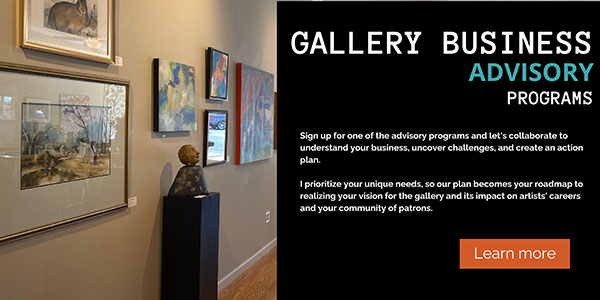Your passion for art developed at some point, leading you to work in a gallery. It also helped shape the vision for the gallery you are in today. This vision is crucial to your gallery’s business plan and growth strategy.
How do your passion and vision show up in the gallery? Are they driving growth through leadership in the gallery business?
Let’s explore how a vision statement can benefit you and the overall task of managing the gallery. We will also discuss how to create a statement you can use as a tool for your gallery’s success and to cultivate a sense of fulfillment in your business.
Benefits a Vision Statement Provides for Running the Gallery
Creating a vision statement is essential for your art gallery because it is a foundational guide for strategic decision-making and everyday operations. A well-defined vision statement does more than communicate your gallery’s purpose; it encapsulates your long-term aspirations, reflecting the unique value it intends to bring to the art world and your clients and artists.
Here are some of the ways a written vision statement can benefit you and your leadership.
- Guides Strategic Planning: A vision statement gives clarity on where the gallery aims to go, helping set clear goals and prioritize actions that align with that future. It ensures that everyone, from the owner to the staff, understands the gallery’s primary mission and overarching direction. In other words, it’s your roadmap.
- Inspires and Motivates the Team: Art gallery staff are more likely to feel engaged and motivated when they’re part of something meaningful. A compelling vision provides them with a sense of purpose beyond daily sales targets. This goes a long way to encouraging a unified and loyal team culture.
- Builds Brand Identity and Differentiation: A vision statement helps the gallery carve out its niche and stand apart from competitors. It signals what the gallery stands for, whether that’s promoting emerging artists, fostering community engagement, or supporting a particular art movement or genre.
- Enhances Customer and Collector Loyalty: When the gallery’s purpose and aspirations are clear, clients and collectors are more likely to feel a deeper connection to its mission. This sense of shared vision can cultivate long-term advocacy, particularly among buyers who align with the gallery’s values and goals. This is an increasingly important trend with younger collectors.
- Attracts Potential Partners and Artists: Galleries often work with various stakeholders, including artists, other galleries, curators, and sponsors. A strong vision can help attract these collaborators by showing the gallery’s commitment to its mission and its plans for growth and impact.
- Supports Adaptability and Resilience: Having a vision allows a gallery to stay anchored during times of change or challenge. It provides a touchstone for decision-making, enabling the gallery to adapt without losing sight of its long-term aspirations.
By clearly articulating what the gallery hopes to achieve and why, a vision statement helps turn an art gallery into more than just a space for sales—it becomes a purpose-driven institution with a lasting influence on both the art community and its patrons.
Today’s Relevancy of Your Gallery Vision
If you’ve been in business for a while, think about whether your initial vision still holds true today. It’s common for the original idea to get lost among the many tasks and lessons learned in those early years.
It’s easy to lose sight of the big picture and get caught up in daily tasks. Outside influences might affect how relevant your initial vision is in today’s market. These influences could include new client demands, artists leaving the gallery, or changes in neighborhood dynamics affecting the gallery’s location.
That’s why it’s crucial to document your vision for the gallery business. You may have done this in a business plan at the start and then never revisited it.
Consider whether your vision for the gallery is still relevant or if it needs to evolve for long-term success. This is an important question that a vision statement can help answer.
Creating a Gallery Vision Statement
First, let me clarify that a vision statement is different from a mission statement. Your public-facing mission statement explains what the gallery does now and for whom. A vision statement is often an internal message that describes how the gallery will be in the future. It guides your planning priorities and inspires leadership.
Create a written gallery vision statement that is easy to update over the years. Imagine what your gallery will be like 3-5 years from now. Use the questions below to guide your thoughts on what to include in your gallery’s vision statement:
- Do you see a larger exhibition space, an online-only gallery, or a move to a different location?
- How will people feel about working with your gallery? Will staffing roles change?
- Why will your artists be loyal?
- What motivates your employees to come to work every day?
- How do you envision your role 3-5 years from now? Will you step back from daily activities or focus more on a specific area of the business?
- How do you want to feel about your gallery business?
- How do you want your clients, employees, and artists to feel about being part of your vision?
- What role will the gallery play in your market and community?
- How will the business operate internally? Will current processes be streamlined, improved, or eliminated?
- What will the company culture be like in the future?
These questions are meant to help you think about the direction you want your business to go and the factors that will contribute to its success. Your vision statement shows you and others how your leadership activities fit into the art gallery business plan for the future. Start with the end result, not where your gallery is currently. Remember, this is all about working towards the future.
I recommend thinking three to five years ahead. You want your vision statement to be far enough in the future to work towards but not so far that it feels overwhelming or like guesswork. This time frame is motivating and still attainable. Your statement will be a valuable tool as you grow and scale the business.
Examples to Inspire Your Gallery’s Vision Statement
Writing your vision statement can be a difficult task for many. After all, you must dig deep and ask many questions to gain clarity. Here are some example vision statements that might inspire you to create a new one or rethink your current vision statement. These vision statement examples are designed to keep your leadership focused on the gallery’s desired future, setting a clear, inspiring benchmark for what the gallery business strives to become.
They provide direction for long-term planning and can help establish priorities for resource allocation, partnerships, and operational focus over time. Each is tailored to a unique focus or mission. You might combine a few ideas into a single statement that most accurately reflects what you are open to be for your artists, clients, and community.
- Contemporary Art Innovator: “To become a groundbreaking institution known for redefining the boundaries of contemporary art, where bold curation and innovative exhibits set trends that influence and shape the broader art world.”
- Community-Centered Hub: “To evolve into a community cornerstone where art not only exists but thrives as a vital part of local culture, empowering diverse voices and fostering a connected, engaged community that values creativity as an essential part of life.”
- Digital Pioneers in Art Accessibility: “To lead the art industry in digital innovation, creating an immersive, accessible art experience that connects audiences worldwide, making our gallery synonymous with cutting-edge technology and inclusive art engagement.”
- Sustainable Art Advocate: “To establish our gallery as a leader in sustainable practices, recognized for our commitment to eco-conscious exhibitions and a supportive environment for artists championing environmental themes—where every choice we make reflects our dedication to a healthier planet.”
- Cultural Legacy Builder: “To be celebrated as a cultural institution that leaves a lasting legacy, not only showcasing remarkable artists but shaping the future of art appreciation, education, and collecting for generations to come.”
- Voice for Underrepresented Artists: “To become a premier destination known for amplifying underrepresented voices in the art world, building a collection and exhibition history that transforms the narrative around diversity in art and inspires future generations.”
- Leader in Art Education and Collector Engagement: “To be a trusted source of knowledge and guidance for art collectors at every level, creating lifelong patrons who feel inspired and empowered by our educational resources and expertise.”
- Experimental Art Destination: “To be recognized as the go-to destination for groundbreaking, experimental art experiences, attracting visionary artists and an audience eager to explore the outer edges of creativity in ways that challenge, surprise, and inspire.”
These examples are simplified to core visions. You have the freedom to include many different aspects of the business as well. They are intended to be a tool for running the gallery. I wanted to show you examples that describe how your gallery might look in the future. After all, these are vision statements, not mission statements.
Why is a Written Vision Statement Important?
Research shows that businesses with a written vision statement grow 50% faster than those without. WOW! Having your vision written down, rather than just in your head, makes it easier to refer back to, share with others, and track your progress in making it a reality.
Don’t worry about perfection. Your vision statement can change over time. Your interests may shift, and new opportunities might arise that excite you, and that’s okay. Just get something down on paper to provide a proper framework.
You can certainly make your vision statement more in-depth than the examples above, but I recommend not going beyond 1-2 pages. It should be easy to understand. Having a written statement will help guide you during your year-end business review, annual planning, and goal setting and keep your tactical planning focused on your future vision.
To the Point
An art gallery vision statement serves as a blueprint for your priorities in customer service, branding, sales, marketing strategies, and future growth. Your vision should be at the heart of your art gallery business plan each year, guiding how you run the business and make decisions. Let your vision be the unifying force that drives purpose and forms the foundation for communicating the value you offer to artists and collectors.
Make sure that not only gallery staff but also your artists and, to some extent, your collectors understand your vision for the gallery’s future through brand awareness. Followers support a gallery’s vision built on clear values, character, and the ability to communicate in an inspiring way.
Check out these articles too
Art Gallery Leadership Skills
How to Create an Annual Art Gallery Strategy Plan



Leave a Reply